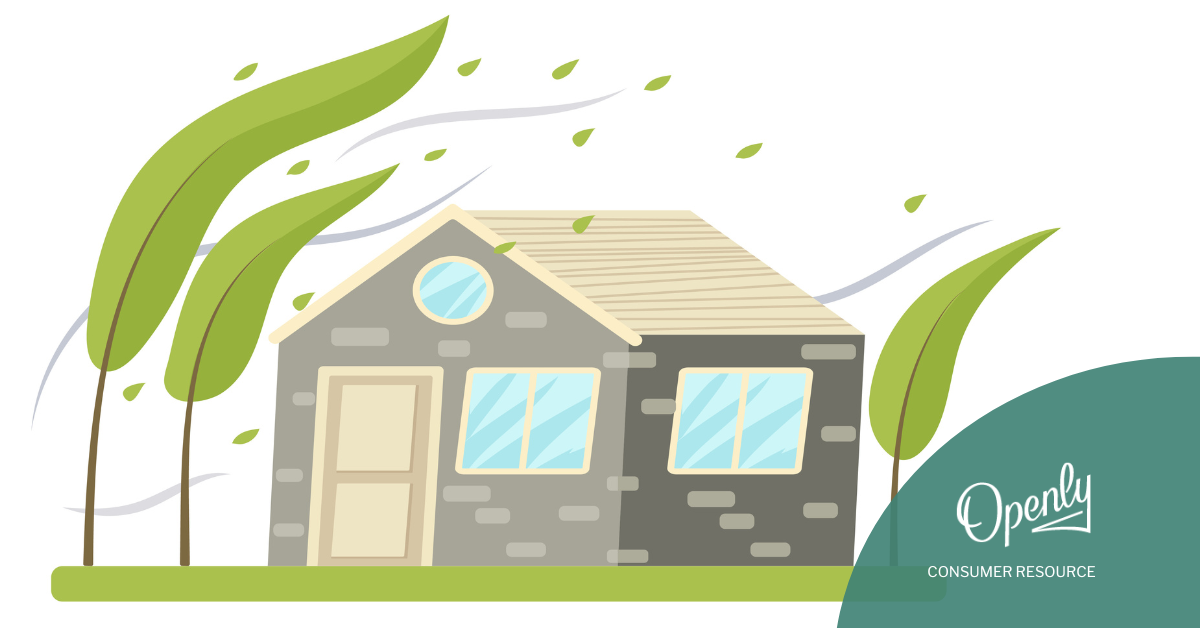Windstorm mitigation inspections are examinations of your home designed to assess a home's ability to withstand high winds, hurricanes, and other severe weather events. These inspections are crucial for homeowners residing in hurricane-prone regions, as they help identify potential vulnerabilities and implement measures to enhance the structural integrity of their homes.
Keep reading to learn more about windstorm mitigation inspections and how you can protect your home.
At a glance:
- Windstorm mitigation inspections assess a home's ability to withstand high winds and identify areas for improvement to reduce damage and potential insurance premiums.
- Windstorm mitigation inspections encourage proactive home protection measures to prepare for severe weather events.
- These inspections examine roofing, windows, doors, and structural connections, identifying vulnerabilities like inadequate roofing materials and weak roof-to-wall connections.
Understanding windstorm mitigation inspections
A windstorm mitigation inspection is a thorough examination of a home's exterior and structural components to identify points of weakness that may increase risk of wind damage. The purpose of a windstorm mitigation inspection is to identify areas that can be improved to prevent, or at the very least lessen, the impact of high winds to a home.
Why these inspections are essential for homeowners
According to the most recently available data, between 2018 and 2021 5.8% of homeowners filed a claim, with 2.8% of them being for wind and hail damage.1 As this data shows, windstorms pose significant threats to homes, ranging from minor roof damage to complete structural collapse.
High winds can cause:
- Roof damage— Winds can lift shingles, tear off sections of roofing, and even cause entire roof collapse.
- Window and door damage—Broken windows and doors allow wind and rain to enter the home, causing significant damage to the interior and posing safety risks to those inside.
- Structural damage—High winds can weaken and even collapse the walls, foundations, and other structural elements of a home.
- Debris impact—Airborne debris, like tree branches and loose objects like patio chairs, can cause severe damage to windows, siding, and other parts of the home.
Windstorm mitigation inspections can reveal these vulnerabilities before they become critical issues. This proactive approach provides invaluable peace of mind and can significantly reduce the financial burden , and subsequently the stress, associated with storm damage.
The windstorm mitigation inspection process
Windstorm mitigation inspections are conducted by certified inspectors who have experience and expertise in building science and wind engineering to accurately assess a home’s vulnerability to wind damage.
The windstorm mitigation inspection process typically involves an examination of several parts of a home's exterior and structural components. These can include2:
- Roofing —Careful examination of the type of roofing materials used, their condition, and the quality of their attachment to the structure. This inspection also includes assessment of the condition of flashing, gutters, and downspouts.
- Windows and doors—Inspectors will evaluate the strength and security of windows and doors, the presence and condition of shutters, installed impact-resistant glass, and other protective measures.
- Roof-to-wall connection—Inspectors will examine where the trusses connect to the walls of the home for potential vulnerabilities.
- Secondary water resistance—Assessment of the condition of secondary water resistance features, which are typically found in the attic and serve as a second level of protective measures against windstorm and rain damage.
Common findings during inspections
Having a thorough windstorm mitigation inspection can significantly impact a home's resilience to storms. From addressing concerns, to pursuing appropriate mitigation measures, homeowners are able to substantially reduce the risk of damage and protect their families and property.
Common issues that may be identified during a windstorm mitigation inspection can include:
- Inadequate roof coverings—Outdated or poorly installed roofing materials, such as asphalt shingles that are nearing the end of their lifespan or improperly secured roofing, is especially susceptible to wind damage.
- Lack of anchoring or reinforcement—Insufficiently anchored roof structures, weak connections between the roof and walls, and inadequate reinforcement of critical structural elements can increase the risk of wind damage.
- Absence of storm shutters or window coverings—Homes with inadequate protection for windows and / or doors are more susceptible to water damage and flying debris.
Impact on homeowners insurance premiums
One of the significant benefits of having a windstorm mitigation inspection is the potential for significant savings on homeowners insurance premiums. Many insurance companies offer discounts to homeowners who have taken proactive steps to improve their home's resistance to wind damage.
The types of credits or premium reductions available can vary depending on the specific mitigation measures implemented and the insurer's underwriting guidelines. Some common examples include:
- Roofing material discounts—Depending on their home insurance provider, homeowners who choose to install high-wind-resistant roofing materials, such as impact-resistant shingles or metal roofing, may qualify for premium reductions.
- Hurricane shutter credits—Installing hurricane shutters or impact-resistant windows and doors may result in significant premium discounts, depending on their home insurance policy and carrier.
- Roof-to-wall connection credits—Reinforcing the connections between the roof and walls can also lead to premium reductions.
- Secondary water resistance credits—Installing high-quality house wraps and underlayment can qualify for premium discounts.
Any discounts, credits, or reduction in premiums to a homeowners insurance policy are dependent on a number of factors, including the insurance carrier and specific policy. It is recommended that homeowners review their policy thoroughly to determine their level of coverage, and to speak to their insurance agent about available discounts that can be earned by upgrading roofing materials, installing hurricane shutters or secondary water resistance materials, and more. 
Benefits of a windstorm mitigation inspection
The benefits of getting a windstorm mitigation inspection extend beyond potential insurance rate reductions:
- Improved safety—The safety of loved ones’ should be of paramount concern to any homeowner. Identifying and addressing vulnerabilities as a result of a windstorm mitigation inspection can ensure the safety of the home’s occupants during any severe weather event.
- Proactive home protection—Windstorm mitigation inspections empower homeowners to be proactive in their approach to home protection. This not only protects those living in the house, but also ensures the home itself is better prepared to withstand severe weather.
- Increased property value—Homes with proven windstorm mitigation features can have a higher market value, depending on their location and condition, making them more attractive to potential buyers.
Preparing for potential severe storm impacts
Once a windstorm mitigation inspection has been conducted, homeowners can—and should—take steps to implement the improvements recommended by their inspector. These steps may include the following:
- Installing mitigation features—Installation of recommended mitigation upgrades can include upgrading of the roof to new materials, reinforcing roof-to-wall connections, and even adding storm shutters or impact-resistant windows and doors as an added level of protection.
- Regular maintenance—Regularly inspecting and maintaining the home, such as checking for loose shingles, scheduled gutter cleanings, and ensuring storm shutters are in good working order is important to ensuring these measures are effective and capable of withstanding severe storm damage.
- Creating an emergency preparedness plan—Developing and practicing an emergency preparedness plan for the entire family is beneficial for many scenarios, including severe weather and even fires. This plan should include evacuation routes, communication plans, and roles for all members of the household. Consider proactively making a checklist and storing in an easily accessible place so you can grab it in the event of an emergency.
How to schedule a windstorm mitigation inspection
If you don’t know where to start, but want to schedule a windstorm mitigation inspection, consider taking the following steps to get started:
- Research and contact certified inspectors—Research certified windstorm mitigation inspectors in your area. Look for inspectors with experience in building science and wind engineering. Be sure to check out their customer’s online reviews for real-life examples and feedback.
- Prepare necessary documents—Gather relevant documentation, such as building plans, previous inspection reports, and insurance policies.
- Inform your insurance agent—Be sure to let your insurance agent know that you’ve scheduled a windstorm mitigation inspection. They may be able to provide guidance on the inspection process and the types of mitigation measures that may qualify for discounts to your home insurance premium.
Enhance your home's safety & reduce risk
Windstorm mitigation inspections are an important part of homeownership, even if they are lesser known. Whether or not you live in a hurricane-prone region or not, severe storm damage is no joke and homeowners should take proactive steps to reduce the likelihood of damage or loss to their property.
Through a thorough evaluation and assessment of their home’s potential vulnerabilities, windstorm mitigation inspections can potentially result in an improvement to the home’s safety, reduce the risk of damage, and potentially lower insurance premiums. Windstorm mitigation inspections not only empower homeowners to ensure their home is better equipped to withstand severe weather events, but they can also find peace of mind knowing their homes are better protected.
Openly offers comprehensive home insurance that goes beyond basic coverage. We understand that every home is unique and deserves a customized approach to home protection which is why our policies can be tailored to your specific needs and the risks your home faces, which can include windstorm damage. Choosing Openly, homeowners get expert local guidance from independent insurance agents, making the often-complex process of insuring your home more straightforward and secure.
* We provide this information to help you understand insurance. Any coverage is subject to the terms of your policy. Please refer to your policy and declarations page for complete terms, conditions, exclusions and coverage details.
1 Insurance Information Institute. “Facts + Statistics: Homeowners and renters insurance“ III.org. Accessed 23 January 2025. https://www.iii.org/fact-statistic/facts-statistics-homeowners-and-renters-insurance#:~:text=In%20the%20five%2Dyear%20period,of%20homes%20having%20a%20loss.
2 20/20 Inspection Solutions. “What is a Wind Mitigation Inspection.” Accessed 23 January 2025. https://2020inspectionsolutions.com/wm/




